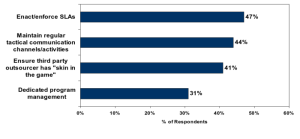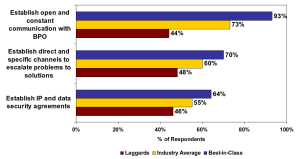
In today’s highly competitive and increasingly globalized technology market, business process outsourcing (BPO) has become one of the hottest trends in organizational structuring. Leading countries, such as India and Mexico as well as newcomers like Brazil, China and Eastern Europe, have emerged as important outsourcing centers.
Additionally, the line between IT outsourcing (ITO) and BPO is starting to blur. Because of this, companies are demanding that their BPO providers decrease operating expenses and improve process efficiencies. These are made possible by automating business processes, precise usage of quality management and process improvement methodologies, as well as a focus on customer intimacy, deep domain expertise, and data-driven management methods for achieving excellence in business processes.
SLAs Keep Costs Down
Analyzing data from more than 170 survey respondents from various global organizations, Aberdeen highlights how Best-in-Class organizations are instituting well-defined service level agreements (SLAs) as part of a holistic approach to their BPO initiative not only to decrease expenses, but also to realize the added benefit of increased levels of customer satisfaction.
As the pressures associated with competition and globalization mount, many organizations are turning to business process outsourcing (BPO). Currently, the top two reasons organizations are deciding to outsource their business processes involve the needs to decrease operating expenses and improve process efficiencies.
To respond to the pressures associated with expenses and process efficiencies, the top two strategic actions organizations implemented to succeed when outsourcing business processes were to enact / enforce SLAs and dedicate sufficient management time for project management. The importance of enacting and adhering to well-defined SLAs cannot be overemphasized. In fact, that action was also the number one action taken by Best-in-Class organizations (Figure 1).
Best-in-Class organizations are able to achieve such a demonstrably higher level of their SLA goals because their actions are geared to achieve that end. By maintaining regular tactical communication channels and activities, Best-in-Class organizations are able to assess, on an ongoing basis, the current performance of their outsourcing goals and make the necessary adjustments to ensure their progress continues.
‘Skin in the Game’
Of particular note is that the Best-in-Class, unlike Industry Average and Laggard organizations, place a high priority on ensuring that their BPO provider has “skin in the game.” By contractually stipulating (oftentimes through a joint venture partnership) that the BPO provider has a financial incentive to meet or surpass the outsourcing relationship goals and maintaining regular contact to troubleshoot any problem areas, Best-in-Class organizations are realizing a marked increase in the percentage of their SLA goals that are met. Given the high level of SLA goals met, it comes as no surprise that the increase in customer satisfaction for Best-in-Class organizations is more than twice that of all other organizations.
In fact, Best-in-Class organizations are 89 percent more likely to have clear SLAs in place than all other organizations. Well defined SLAs are the foundation of a successful outsourcing relationship. If the goals and expectations of the relationship are clearly articulated from the start, the odds of achieving those goals increase exponentially. Possession and enforcement of these well defined agreements allow Best-in-Class organizations to realize a more than 100 percent greater increase in the level of customer satisfaction than all other organizations.
Additionally, Best-in-Class organizations are 141 percent more likely than Laggards to measure BPO compliance with contract objectives. Also, 38 percent monitored their communications with their BPO provider. Best-in-Class organizations acknowledge that the success of a BPO relationship is determined by adherence to SLAs. They also understand that adherence to SLAs is based on the ability to measure that the outcomes of the BPO relationship match or exceed those stipulated by the contract. Through such techniques as ensuring “skin in the game,” Best-in-Class organizations constantly measure and proactively ensure that all contract objectives are fulfilled. Once processes are standardized and consistent measuring techniques are employed, many organizations are now benefiting from the optimization tools BPO vendors employ. These tools include automation and consolidation options that can significantly reduce operating expenses through faster product turn-around.
Mitigating the Risks
To succeed in an outsourcing relationship and realize customer satisfaction gains, strong and consistent SLA performance is a necessity. However, as BPO as a whole evolves, one action that all organizations can take to help ensure SLA performance, keep their customers happy, and reduce operating costs is to proactively mitigate the risks associated with outsourcing (Figure 2).
The risk mitigating tactics illustrated in Figure 2, though different in application, all share a very important foundation: constant communication. The inability to communicate in a timely and consistent manner with the outsourcing provider invites the opportunity for costly problems and setbacks to hamper the effectiveness of the outsourcing relationship.
Regardless of whether you are a Laggard, Industry Average, or Best-in-Class organization, ensuring that consistent communication channels stay open in general, and following the more general recommendations listed below, any organization can boost the effectiveness and efficiency of their current or upcoming outsourcing relationship.
- Focus on operational cost reductions. This is made possible through process improvements, reengineering, and use of technologies that reduce and bring administrative and other costs under control. Equally important strategic benchmarks include acceleration of business and technological changes and access to new domain skill sets.
- Focus on “core versus context” operations. Focus on the company’s main business by outsourcing non-core processes to enable the management team to impart more time to building the company’s core businesses, develop new products, expand into new markets, and enhance customer service and satisfaction.
- Focus on BPO providers with deep domain expertise. Having a BPO provider with domain experts ensures you are gaining operational efficiencies, the needed guidance, and skills rather than recruiting and training personnel internally or within the provider themselves. The BPO provider must have a strong and unique BPO competency in order for a migration to be successful. The lack of such competency could expose businesses to substantial costs or even complete operational failures. Because of these required competencies, don’t treat BPO service provisions as a commodity-like service (unlike ITO). Focusing on providers with specific domain expertise has the added benefit of bringing innovation and key business insights to the table.
- Focus on BPO providers with flexible and scalable services. With constantly changing customer demands ensure they have the services to meet your changing business requirements, support for M&A activity, consolidations, joint ventures, or Build Operate and Transfer (BOT) initiatives.
- Focus on BPO providers with industry specific open software architectures and platforms to meet the vertical specific challenges of individual business processes to help maximize process automation. Additionally, providers with SOA architecture platform capabilities enable interoperability with existing legacy architectures. This open architecture will help to eliminate the need to purchase and integrate traditional IT components such as business process workflows, CRM applications, EAI, imaging, and other enterprise technologies — making it attractive to global companies seeking greater returns from IT investments in the form of reduced cost, reduced risk, and reduced time to market.
Ralph Rodriguez is a senior vice president of research in the technology markets group of the Aberdeen Group. He can be reached at [email protected].














































Social CRM
See all Social CRM